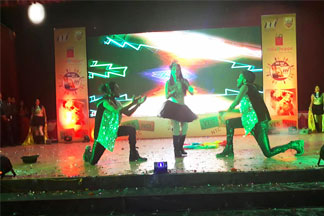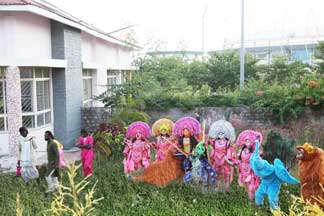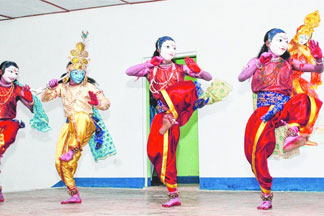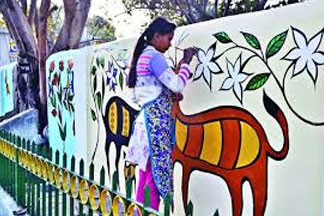ORAON
Oraon is an important and majority tribe of Jharkhand. Sathal's dispute is its second position. According to the census of 1994, total population of Oraon1 137666, mainly in old districts Ranchi (76.19 per cent), Palamu (43-82 per cent), Brijarival (5 per cent), Singhbhum (3.62 per cent) and Sanpal Paragana (1 13 Percent). Oraon is called 'Kurukh' in your language. The word kurukhhu is related to the Sanskrit ambitu 'karsha' (hull), which became cooper, kuhushar, kurukhhu through traction. Being from 'traction' to 'kurkhar' from 'traction' is related to Nasikta. It is also believed that the name of khukh may have been originally derived from extinct garlic metal, which means 'human'. Traditionally, in all the tribes, there is a tradition of saying human only by not telling any caste. Moda or Ho is called Horo (Human). The word 'Cole' which seems to be used collectively for the entire tribe (Munda too) is the original meaning - human. Similarly, 'Male' (tribe) means Jan, Ashkimo is called "Inuit". It also means money. Kalahari '- living in the desert' Bushman 'and Hontotot' calls itself 'lost', which also means 'human'. Homophobia is a great feature of tribals in humans, whose development can only establish unity in diversity. The word 'Karman', which is derived from the Rigveda, is used in the form of an expression of 'Jan'. Vedas, Brahmins and Samhita have been mentioned as "Five People". A big interesting description of the origin of this name is found in a Oraonfolklore. First, in the distant past, a muni ascetic, remained absorbed in penance in the same posture for years of non-food. During this long period, his body turned into a balmiki or bandi, i.e. termites covered by late. A shredded tree came up in which a long - 3 3 entered into their ur (chest) In the end, a logarithm forgetting the muni as a termite of the termite, it was broken by the bent of Kulharri and broke it, but he remained silent. When found a living man Due to this in a rude manner, the deviated monk stood abreast of being young. Then the thorn thorn in his chest broke and the blood started flowing. The mother (mother) did not have blood stains, by this desire she filled her in Anjali. When they experienced the relapse, they did not give the address and filled it with blood and put them in a shady place nearby. With this blood, a boy and a girl (brother-in-law) appeared. Then the muni walked from here. From that point of view, those people who saw Muni go, do not leave and leave. You have brought us into the world. How will our livelihood work? "Muni replied," You will become a farmer, you will become a farmer. Clean this forest and make cultivation your profession. "These were the first ancestors (parents) of Ueno, who were born from the blood of Muni's 'ur', hence 'Uraon', here it is important that it is fine In relation to the origin of four types of this type of story, there is also that the Brahma's head, the karmas from the arms, arms or chest, drunk by the Vaishya and the feet from the abdomen Anatomy: Oraonis kept in the proto-aqualoid group from a species point of view. Their stature is small, cranium gallery-narrow, nose wide, the color is almost dark, and black, black, rough, sometimes wavy or horny. Dense hair on the head but less on the body, like Cena, in Per. Eyes are moderate, sometimes smaller and puppets are black. Peri is athletic and cena is square. The nose is fog near the root. The lips are thick and thin. The average height is 162.1 cm maximum 174.4 cm from the humanitarian figures of Oraonby Rijale. And minimum 148 cms. found . In the same way, their average cranial-population (Cf) was found to be 75.4 and higher, 87 and 67 were found. The geographical environment of Jharkhand influences the colors and bodybuilding of Uran Done Due to the frost climate here, due to the color of the Deccan's ancestors, some 'faded' Their components are balanced, shoulder-to-strong and puffs are strong. Similarly, by washing the burden of two minds Do not experience difficulty in wearing bunting or weight on the shoulder. Food: The main food of Urenov is rice (boiled rice) and greens vegetable. Gondali mahua, wild tuber root, greens, mahua flowers and other fruit flowers are also part of their food. Chadas also eat. Dried rice, many varieties of lentils eat many types of vegetables. Normal people eat fewer pulses. By sharing the words in the month, especially after splitting greens and salt turmeric, it creates a type of lump. The use of oil is less. Dung-curd-ghee is rare. These are Sahari. Eggs, chickens and various types of animals eat meat. The common people can get the food and drink only. Now the victim has not been offered to them, the hobby is hobby. Occasionally do hunt. All kinds of fish, animals and birds eat Eat the rat and crow's bite. Monkey does not eat meat. This is a taboo for the entire society. Hudia is their favorite drink, which is used for freezing. Debi-Devta also seeks the check of the handiwork. Bhoj Bhat, celebration of festivals or guests is considered incomplete without any hindrance. On the occasion of the occasion, the owner of the house - the mistress fast. In the same way, the bride and groom of marriage also fast for one day. Sirohul celebrates non-seasonal greens and fruits. Now the circulation of Arki (Mahua liquor) has increased in Haryana's place. From the circulation of Kheni Tobacco. ' Bash gown: Because of the tropical climate in the state, they used to run in the lower echelons. They used to wear white clothes. Now the use of male dhoti Ganji is'. The traditional 'kyaayya' is still in vogue, which is five yards tall and a one-half-hand four-edged cloth, with a colorful swelling on both ends, keeps the nyakshasa. Wear (Kamarghani) in the waist. The poor-rustic saffronis are used. On the way out, the body covers the sheet (sheet) which is a two-yard tall and one-and-a-half-cubit wide piece of cloth. 'Barkhi' in the jungle is used in a common way. Rich people also use blanket-quilts. The syllable (cap, pagdi) is not commonly used in the experiment. On special occasions, the head uses pargri and hawkers. Uses kspa (slippers). In the rainy season, the use of the 'hidden' (Gangu address) is used by men and Budh (sticks with umbrellas). The use of the umbrella of the bones, especially when used in farming, ropeway or hot winter wear. Now the new people have started using pants, shirts, coats, shoe, stocking slippers etc. The houses are also started to bind. Jewellery: Jewellery is a natural affair among women, but due to poverty, the common women do not wear gold ornaments. Some wealthy households wear gold ornaments. Oraon women are often made of bronze, iron ore or other inexpensive metal. Jewelry is also made from corn, seeds, yarn, coconut oil. Necklaces in neck, necklaces, or necklaces of syringes, wears sikadi. In the ear, 'Bindiya' or 'Swati Kani' and 'Beach Kani' in the nose, weave the nose in the nose, 'Mundi (ring) in the nose and' padi 'in the Katari and the peres. It is considered compulsory to wear paddies by the bride at the time of marriage. Seven brass waffles and one rosanna on both arms are used to spit from kali to kehuni. Bah, ears and throat are left empty (Without any jewelry, no worries, they wear comb and khongsu in the jugular.The men also wear brass knots in the wrist and wear necklaces made of grass or glass grains in the neck. To keep the forearm, the feet of the forehead use the "wallet" (dressing shop). Jatra or Parva Feet, in the time of dancing, Sahila thorns, feathers are thrown in the head, the talisman-Jantar also wear. The practice of fondation is prevalent: In the seven-eight year old age, two bellies are given on the women's frontal necklace and the same is done at the age of 11- 1, the rituals, arms, backs, The flowers are made in tattoo, and flowers are made in tattoo, flowers are used in tattoo, etc. The women give a very important importance to tattooing, among them there is a saying, "On death, all the jewels are taken away, but tattooing will go along with other worlds." Introduction:
Introduction:







